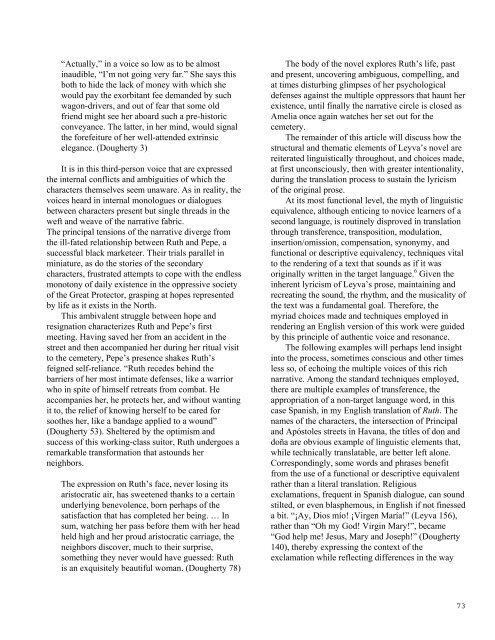their - The University of Texas at Dallas
their - The University of Texas at Dallas
their - The University of Texas at Dallas
Create successful ePaper yourself
Turn your PDF publications into a flip-book with our unique Google optimized e-Paper software.
“Actually,” in a voice so low as to be almost<br />
inaudible, “I’m not going very far.” She says this<br />
both to hide the lack <strong>of</strong> money with which she<br />
would pay the exorbitant fee demanded by such<br />
wagon-drivers, and out <strong>of</strong> fear th<strong>at</strong> some old<br />
friend might see her aboard such a pre-historic<br />
conveyance. <strong>The</strong> l<strong>at</strong>ter, in her mind, would signal<br />
the forefeiture <strong>of</strong> her well-<strong>at</strong>tended extrinsic<br />
elegance. (Dougherty 3)<br />
It is in this third-person voice th<strong>at</strong> are expressed<br />
the internal conflicts and ambiguities <strong>of</strong> which the<br />
characters themselves seem unaware. As in reality, the<br />
voices heard in internal monologues or dialogues<br />
between characters present but single threads in the<br />
weft and weave <strong>of</strong> the narr<strong>at</strong>ive fabric.<br />
<strong>The</strong> principal tensions <strong>of</strong> the narr<strong>at</strong>ive diverge from<br />
the ill-f<strong>at</strong>ed rel<strong>at</strong>ionship between Ruth and Pepe, a<br />
successful black marketeer. <strong>The</strong>ir trials parallel in<br />
mini<strong>at</strong>ure, as do the stories <strong>of</strong> the secondary<br />
characters, frustr<strong>at</strong>ed <strong>at</strong>tempts to cope with the endless<br />
monotony <strong>of</strong> daily existence in the oppressive society<br />
<strong>of</strong> the Gre<strong>at</strong> Protector, grasping <strong>at</strong> hopes represented<br />
by life as it exists in the North.<br />
This ambivalent struggle between hope and<br />
resign<strong>at</strong>ion characterizes Ruth and Pepe’s first<br />
meeting. Having saved her from an accident in the<br />
street and then accompanied her during her ritual visit<br />
to the cemetery, Pepe’s presence shakes Ruth’s<br />
feigned self-reliance. “Ruth recedes behind the<br />
barriers <strong>of</strong> her most intim<strong>at</strong>e defenses, like a warrior<br />
who in spite <strong>of</strong> himself retre<strong>at</strong>s from comb<strong>at</strong>. He<br />
accompanies her, he protects her, and without wanting<br />
it to, the relief <strong>of</strong> knowing herself to be cared for<br />
soothes her, like a bandage applied to a wound”<br />
(Dougherty 53). Sheltered by the optimism and<br />
success <strong>of</strong> this working-class suitor, Ruth undergoes a<br />
remarkable transform<strong>at</strong>ion th<strong>at</strong> astounds her<br />
neighbors.<br />
<strong>The</strong> expression on Ruth’s face, never losing its<br />
aristocr<strong>at</strong>ic air, has sweetened thanks to a certain<br />
underlying benevolence, born perhaps <strong>of</strong> the<br />
s<strong>at</strong>isfaction th<strong>at</strong> has completed her being. … In<br />
sum, w<strong>at</strong>ching her pass before them with her head<br />
held high and her proud aristocr<strong>at</strong>ic carriage, the<br />
neighbors discover, much to <strong>their</strong> surprise,<br />
something they never would have guessed: Ruth<br />
is an exquisitely beautiful woman. (Dougherty 78)<br />
<strong>The</strong> body <strong>of</strong> the novel explores Ruth’s life, past<br />
and present, uncovering ambiguous, compelling, and<br />
<strong>at</strong> times disturbing glimpses <strong>of</strong> her psychological<br />
defenses against the multiple oppressors th<strong>at</strong> haunt her<br />
existence, until finally the narr<strong>at</strong>ive circle is closed as<br />
Amelia once again w<strong>at</strong>ches her set out for the<br />
cemetery.<br />
<strong>The</strong> remainder <strong>of</strong> this article will discuss how the<br />
structural and them<strong>at</strong>ic elements <strong>of</strong> Leyva’s novel are<br />
reiter<strong>at</strong>ed linguistically throughout, and choices made,<br />
<strong>at</strong> first unconsciously, then with gre<strong>at</strong>er intentionality,<br />
during the transl<strong>at</strong>ion process to sustain the lyricism<br />
<strong>of</strong> the original prose.<br />
At its most functional level, the myth <strong>of</strong> linguistic<br />
equivalence, although enticing to novice learners <strong>of</strong> a<br />
second language, is routinely disproved in transl<strong>at</strong>ion<br />
through transference, transposition, modul<strong>at</strong>ion,<br />
insertion/omission, compens<strong>at</strong>ion, synonymy, and<br />
functional or descriptive equivalency, techniques vital<br />
to the rendering <strong>of</strong> a text th<strong>at</strong> sounds as if it was<br />
originally written in the target language. 6 Given the<br />
inherent lyricism <strong>of</strong> Leyva’s prose, maintaining and<br />
recre<strong>at</strong>ing the sound, the rhythm, and the musicality <strong>of</strong><br />
the text was a fundamental goal. <strong>The</strong>refore, the<br />
myriad choices made and techniques employed in<br />
rendering an English version <strong>of</strong> this work were guided<br />
by this principle <strong>of</strong> authentic voice and resonance.<br />
<strong>The</strong> following examples will perhaps lend insight<br />
into the process, sometimes conscious and other times<br />
less so, <strong>of</strong> echoing the multiple voices <strong>of</strong> this rich<br />
narr<strong>at</strong>ive. Among the standard techniques employed,<br />
there are multiple examples <strong>of</strong> transference, the<br />
appropri<strong>at</strong>ion <strong>of</strong> a non-target language word, in this<br />
case Spanish, in my English transl<strong>at</strong>ion <strong>of</strong> Ruth. <strong>The</strong><br />
names <strong>of</strong> the characters, the intersection <strong>of</strong> Principal<br />
and Apóstoles streets in Havana, the titles <strong>of</strong> don and<br />
doña are obvious example <strong>of</strong> linguistic elements th<strong>at</strong>,<br />
while technically transl<strong>at</strong>able, are better left alone.<br />
Correspondingly, some words and phrases benefit<br />
from the use <strong>of</strong> a functional or descriptive equivalent<br />
r<strong>at</strong>her than a literal transl<strong>at</strong>ion. Religious<br />
exclam<strong>at</strong>ions, frequent in Spanish dialogue, can sound<br />
stilted, or even blasphemous, in English if not finessed<br />
a bit. “¡Ay, Dios mío! ¡Virgen María!” (Leyva 156),<br />
r<strong>at</strong>her than “Oh my God! Virgin Mary!”, became<br />
“God help me! Jesus, Mary and Joseph!” (Dougherty<br />
140), thereby expressing the context <strong>of</strong> the<br />
exclam<strong>at</strong>ion while reflecting differences in the way<br />
73

















